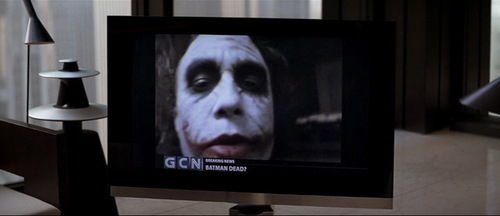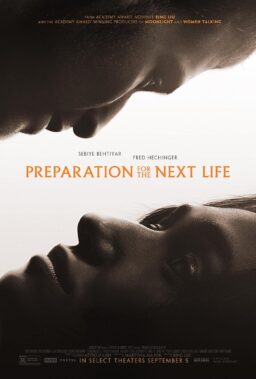At the risk of getting ahead of myself (I can tell from the initial comments, I’m probably already in way over my head), let me directly address (as I have in some comments all ready) one of my primary concerns with “The Dark Knight” and movies in general. And that, simply, is that, as I always like to say, if it’s in the movie, then let’s talk about it. If it’s not — that is, if you’re coming up with some scenario or motivation or explanation that a particular image or sound in the movie does not address — then you can’t pretend it’s part of the movie. Because, manifestly, it isn’t. That’s the difference between Ain’t-it-cool fanboy speculation and actual movie criticism, based on what’s on the screen, not what’s in a previous draft of an unpublished comic somewhere….
So, when I asked (“Dark Knight Quiz #1: What’s wrong with this picture“) for you to consider one of the key shots in “The Dark Knight” (the “punchline,”, if you will, to of the opening sequence), one of the things I wanted to get at is the movie’s conception (or, at least, the audience’s conception) of the Joker as a supernatural being. I’ve found that discussing “The Dark Knight” can be like discussing Intelligent Design — in all the worst ways.
For now, let’s put aside questions of the movie’s violations of its own narrative, character, spatial, temporal, cinematic logic. (“It’s a comic-book movie,” some people say. “It’s not supposed to make any sense!” And yet what genre is more obsessive about the rules of its fictional universe[s] than comics?)
I asked YOU, Dear Reader, to “please leave a comment with your account of the shot AND your assessment of how the Joker planned this getaway. Pay special attention to the timing (dust/debris, busses, traffic signal, arriving cop cars).” My intention was, and is, to get you to look at the shot first, and consider the evidence before your eyes and ears. Why does the shot start where it does, and end where it does? What does it show of the bus’s exit from the bank and what does it not show? What are the various noises on the soundtrack composed to suggest?
I was disheartened when a few commenters suggested that I was attempting to encourage fanboy speculation rather than to practice disciplined film criticism, which involves (as they used to say in my university literature, film, drama, and music courses) a “close reading of the text.” Honest. That’s what I’m after.
Which brings me to this: What do we talk about when we talk about the Joker? I’ve had (and read, and witnessed) many discussions in which it is said that the Joker cannot be trusted (!), that he does not always tell the truth (!), that he is (as he says) an “agent of chaos,” and that he is (as his actions suggest) an obsessive-compulsive or control-freak planner whose personal methods are anti-chaotic, but who desires to create mayhem or anarchy as the result of meticulous planning.
This is where, I think, we get back to Intelligent Design, in which anything that cannot be explained by the evidence before us (i.e., an image or sound in the movie) can be passed off on the wily, (semi-?)omniscient God/Joker, who works in mysterious ways and has no limits on his abilities to anticipate events. The Joker lies. He makes up origin stories about himself. He asks for things (the unmasking and surrender of Batman) that he does not really desire, just to shake things up and foment turmoil. He says things (“You complete me”) that are flattering or insulting but that don’t really mean anything because he is a nihilist who, as Alfred says, just wants to watch the world burn. (Take a moment here to ask yourself how much social anarchy “The Dark Knight” shows us as a result of the Joker’s manipulations. Even those people fleeing on the ferry are so rational and organized that they can conduct an impromptu initiative election [call it Prop 666] on the spot, and every vote is counted. Ah, but that’s because he expects them to go all nihilistic hysterical and crazy and they don’t, so… what?).
OK, consider this: In a badly constructed sequence, we see a Batman lookalike hanged and splatted against the Mayor of Gotham’s window. Later, we see the same thing on television (as Bruce Wayne and Alfred watch). The Batman impostor is lowered to the ground, while in the “live” TV coverage the headline/caption is: “Batman Dead?” Of course, we already know that the real Batman is not dead, but the TV newscaster puts the Joker’s tape on the air, evidently without watching it first. This is a key moment in the film, because it does exactly what the newscaster does to his audience in setting up the footage to follow. Newscaster: “Be aware: The image is disturbing.”
Right! In case we couldn’t tell for ourselves, the image we’re about to see is disturbing. It’s a pre-recorded (i.e., pre-dead Batman impostor) handheld video made by the Joker. And, apparently, it convinces all of Gotham City that Batman has driven the city crazy (by allowing criminals like the Joker to exist within city limits) and that the best solution to the problem is for Batman to unmask himself and surrender to the authorities for… charges unknown. [Vigilantism, of the non-lethal kind?]
Here is my challenge to you now: Taking key lines from the Joker’s tape, I ask you to tell me:
1) Which statements are true?
2) Which statements are false?
3) Which are neither true nor false?
4) Which are both true and false?
5) Which are simply chaotic and anarchical?
AND, most important of all: 6) What evidence does the movie provide to support your readings of 1-5?
Here’s what the Joker says:
a) LOOK AT ME! This is how crazy the Batman’s made Gotham!
b) You want order in Gotham? Batman has to go.
c) So, Batman must take off his mask and turn himself in.
d) Every day he doesn’t… people will die.
e) Starting tonight.
f) I’m a man of my word!
OK, we know the Joker is an agent of anarchy (right? wrong?) and that he’s not a man of his word ’cause he lies like crazy. But maybe he’s crazy like a fox. Or maybe he’s crazy like a crazy person! When is he which, and why does it matter? You tell me.
BONUS: Gordon later says: “The Joker planned to be caught. He wanted me to lock him up in the M.C.U.” Does the movie believe that to be true?
FOR WHAT IT’S WORTH: My guesses are here.











